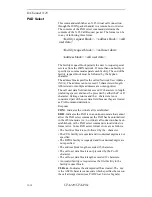
10-2
UTA220/UTA220k
BONDING
PLACING A BONDING CALL
You can place a call from port 1 or port 2 using any normal
means. The answering party must be set to run BONDING or
the call will disconnect shortly after connection. If you specify
a rate multiplier of 2 and the answering party indicates it will
support 2 or more channels for BONDING, the answering side
will pass the directory number for the second call in the
negotiation. The second call is made automatically. You can
tell this call is being made by the flashing LED on the second
B-channel. If delay equalization between the channels is
obtained, data mode is entered. The front panel indicates the
BONDING connection, the B-channel line speed (56 or 64
kbps), and the DTE speed (56, 64, 112, or 128 kbps). The
B-channel LEDs remain on when data mode has been entered.
Note: When a rate multiple of 2 is negotiated, both B-channels
are used. The remaining ports are prevented from making
circuit switched calls for the duration of the BONDING call.
If the rate multiple is set to 1 on either the originator or
answerer, the second call will not be made and data mode will
be entered immediately after negotiation. The second call will
not be made and data mode will be entered immediately after
negotiation. The screen will indicate the speed the call
connected at.
The Directory Numbers configured in the D-channel setup tell
the origination side what the second Directory Number is. If
you are using a point-to-point line with only one Directory
Number, on answering a BONDING call that is requesting two
channels, this directory number will be sent to the origination
side, which is the same number as the first one dialed. This is
because a point-to-point line can receive two calls using the
same Directory Number. AT&T 5E5/5E6 can also be
configured to receive two calls using the same Directory
Number. To use this capability, change port 1’s SEC CALL
PORT (located under BONDING OPTIONS in
CONFIGURATION / PORT) to 1 and set port 2’s SEC CALL
PORT to 2.
DISCONNECTING A BONDING CALL
Disconnecting by any normal means disconnects all
BONDING channels. If either channel is disconnected by the
switch, the entire call is disconnected by the UTA220. The
disconnection can be validated by the LCD screen indicating
DISCONNECTED and the B1 and B2 LEDs being off.
Summary of Contents for UTA220
Page 6: ...vi Preface ...
Page 24: ...2 4 UTA220 UTA220k Installation ...
Page 34: ...3 10 UTA220 UTA220k Getting Started ...
Page 60: ...6 6 UTA220 UTA220k V 25 bis Dialer Operation ...
Page 72: ...9 4 UTA220 UTA220k Rate Adaption ...
Page 76: ...11 2 UTA220 UTA220k Synchronous Operation ...
Page 128: ...15 2 UTA220 UTA220k Maintenance ...
Page 134: ...B 4 UTA220 UTA220k Factory Default Settings ...
Page 156: ...D 8 UTA220 UTA220k Interfaces ...
Page 176: ...G 10 UTA220 UTA220k Abbreviations and Acronyms ...
Page 178: ...H 2 UTA220 UTA220k Status and Connection Messages ...
















































